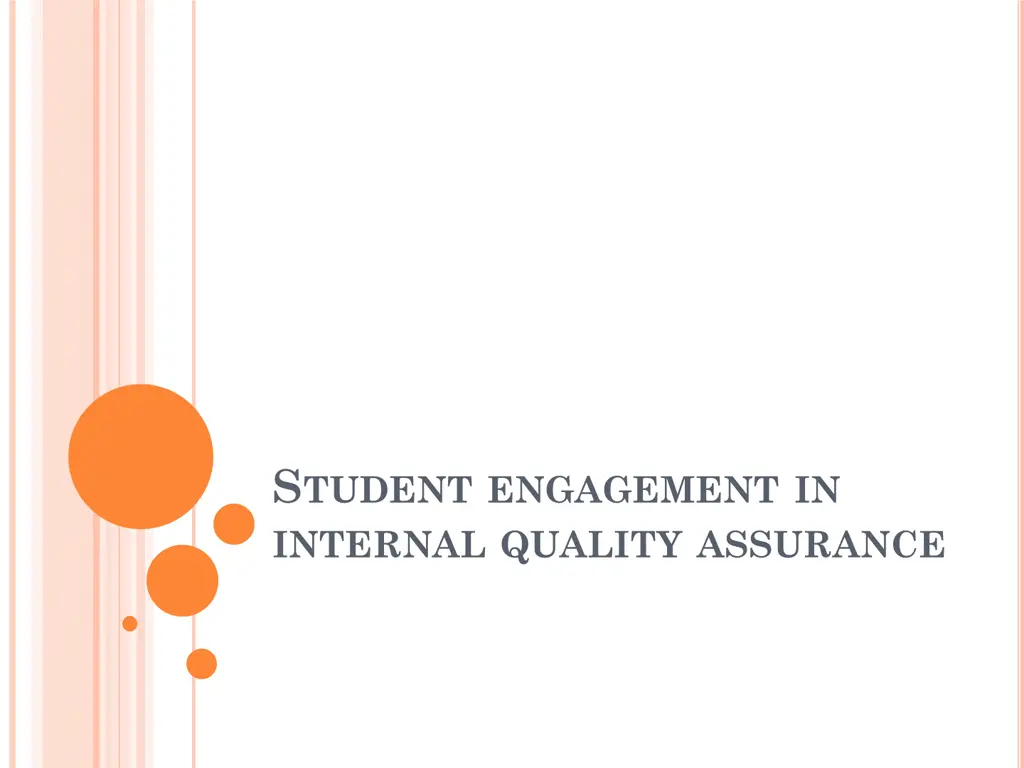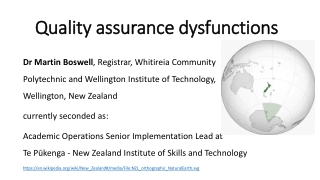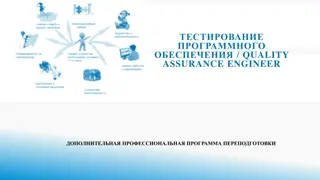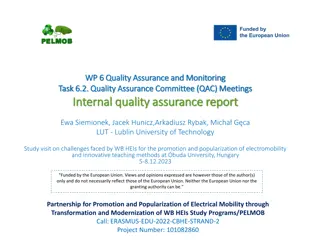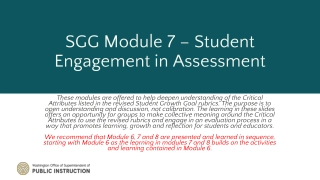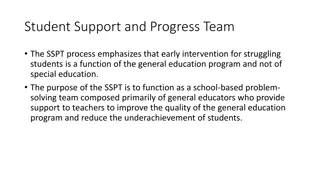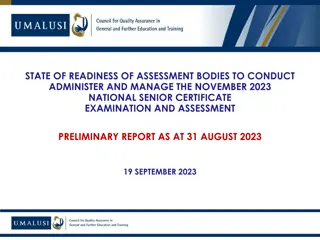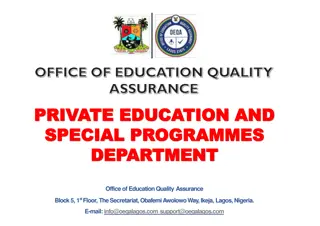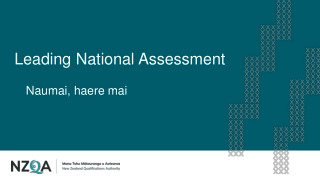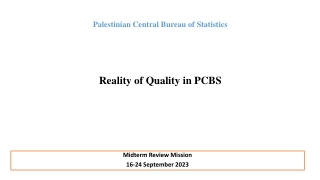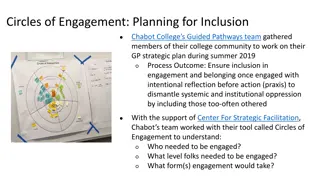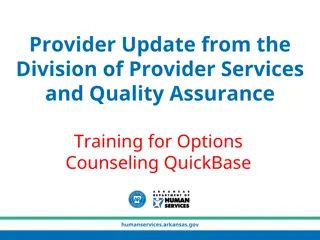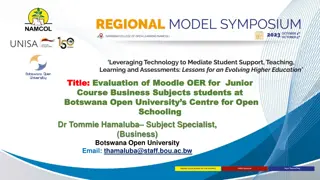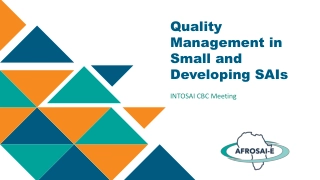Student Engagement in Internal Quality Assurance
Stakeholder engagement in higher education quality assurance, including motivations, avenues, challenges, and strategies for student engagement.
- student engagement
- internal quality assurance
- stakeholders
- higher education
- motivation
- challenges
- strategies
- benefits
Download Presentation
Please find below an Image/Link to download the presentation.
The content on the website is provided AS IS for your information and personal use only. It may not be sold, licensed, or shared on other websites without obtaining consent from the author. Download presentation by click this link. If you encounter any issues during the download, it is possible that the publisher has removed the file from their server.
Presentation Transcript
STUDENT ENGAGEMENT IN INTERNAL QUALITY ASSURANCE
CONTENTS 1. What is Stakeholder Engagement? 2. Who are our Stakeholders? 3. Motivations and Benefits 4. Avenues of Student Engagement 5. Challenges and Limitations 6. Strategies for Stakeholder Engagement 7. Principles of Student Engagement
WHAT IS STAKEHOLDER ENGAGEMENT? Stakeholder engagement in the quality assurance of higher education refers to the active involvement and participation of relevant individuals or groups, such as students, faculty members, administrators, employers, alumni and the representatives of the labour market, in the assessment and improvement of the quality of higher education programs, services and institutions.
WHO ARE OUR STAKEHOLDERS? External Internal 1. Employers/Labour market 2. Alumni 3. Parents 4. Authorities 1. Academic staff 2. Students 3. Administrative staff The ESG defines STAKEHOLDERS as all actors within an institution, including students and staff, as well as external stakeholders such as employers and external partners of an institution.
MOTIVATIONS TO STAKEHOLDER ENGAGEMENT
MOTIVATIONS I STAKEHOLDER ENGAGEMENT AT THE CORE OF DEFINING QA 1. Quality assurance as a process of establishing stakeholder confidence that provision (input, process, and outcomes) fulfills expectations or measures up to threshold minimum requirements (Harvey, 2002); 1. The sum of actions undertaken by the institution to meet the expectations of its internal and external stakeholders as well as the expectations the institution has defined for itself; 1. Other definitions are primarily stakeholder-driven, focusing on accountability to the public or providing a transformative learning experience to benefit students and employers (Bogue, 1998; Harvey, 2005; Haworth & Conrad, 1997; Quality Assurance Agency for Higher Education, 2012; Srikanthan & Dalrymple, 2002, 2004, 2007).
MOTIVATIONS II EUROPEAN POLICY In 1998, the Recommendation on European cooperation in quality assurance in higher education (EU 1998) drafted by the Council of the European Union and the European Parliament mentions the involvement of the different parties concerned according to the purpose of the quality assurance as one of the features that national quality assurance systems should be based on. ? 2001, Prague Communique, students are competent, active and constructive partners in the establishment and shaping of a European Higher Education Area. ? 2003, Berlin Communique, it is ultimately the active participation of all partners in the Bologna Process that will ensure its long- term success. Students are full partners in higher education governance. Ministers note that national legal measures for ensuring student participation are largely in place throughout the European Higher Education Area. They also call on institutions and student organizations to identify ways of increasing actual student involvement in higher education governance. ? 2005, Bergen Communique, adoption of the ESG ?
MOTIVATIONS III ESG INTERNAL One of the 4 core principles the ESG are based on is that quality assurance takes into account the needs and expectations of students, all other stakeholders and society. 1.1. Policy for quality assurance Institutions should have a policy for quality assurance that is made public and forms part of their strategic management. Internal stakeholders should develop and implement this policy through appropriate structures and processes, while involving external stakeholders. It supports the development of quality culture in which all internal stakeholders assume responsibility for quality and engage in quality assurance at all levels of the institution. The policy supports the involvement of external stakeholders in quality assurance. 1.2 Design and approval of programmes Study programmes are designed by involving students and other stakeholders in the work. 1.9 On-going monitoring and periodic review of programmes Programmes are reviewed and revised regularly involving students and other stakeholders.
MOTIVATIONS IV ESG EXTERNAL 2.2 Designing methodologies fit for purpose External quality assurance should be defined and designed specifically to ensure its fitness to achieve the aims and objectives set for it, while taking into account relevant regulations. Stakeholders should be involved in its design and continuous improvement. In order to ensure effectiveness and objectivity it is vital for external quality assurance to have clear aims agreed by stakeholders. 2.3 Implementing processes The written documentation is normally complemented by interviews with stakeholders during a site visit. 2.4 Peer-review experts At the core of external quality assurance is the wide range of expertise provided by peer experts, who contribute to the work of the agency through input from various perspectives, including those of institutions, academics, students and employers/professional practitioners. 3.1 Activities, policy and processes for quality assurance Agencies should ensure the involvement of stakeholders in their governance and work.
MOTIVATIONS V EUROPEAN POLICY 2009, Leuven/Louvain-la-Neuve Communique, the necessary ongoing reform of higher education systems and policies will continue to be firmly embedded in the European values of institutional autonomy, academic freedom and social equity and will require full participation of students and staff. ? 2010, Budapest-Vienna Communique, we note that adjustments and further work, involving staff and students, are necessary at European, national, and especially institutional levels to achieve the European Higher Education Area as we envisage it. We commit ourselves to working towards a more effective inclusion of higher education staff and students in the implementation and further development of the EHEA. ? 2012, Bucharest Communique, we commit to supporting the engagement of students and staff in governance structures at all levels. Together with institutions, students and staff, we will facilitate a supportive and inspiring working and learning environment. ?
MOTIVATIONS VI ? ADDED VALUE (see detailed section of BENEFITS) ? and HONESTLY, BECAUSE WE HAVE TO
BENEFITS OF STAKEHOLDER ENGAGEMENT
BENEFITS OF STAKEHOLDER ENGAGEMENT I 1. Improved quality: We can gain valuable insights and perspectives that can help to identify areas for improvement from a diverse pool of opinions; 1. Increased accountability: When stakeholders are involved in the process, they are more likely to feel ownership over the outcomes and to hold the institution accountable for meeting their needs; 1. Enhanced communication: We can foster a culture of communication and openness that can lead to improved relationships and better understanding of stakeholder needs; 1. Increased transparency: We demonstrate commitment to openness and transparency and provide stakeholders with a better understanding of how the institution operates;
BENEFITS OF STAKEHOLDER ENGAGEMENT II Improved institutional reputation: When stakeholders are involved in the process, they are more likely to feel invested in the institution and to speak positively about it to others. This can lead to increased visibility and better relationships with stakeholders; 4. Enhanced decision-making: By gathering input from stakeholders, the institution can make more informed decisions that are based on a range of perspectives and that take into account the needs of all stakeholders; 4. Increased innovation: When stakeholders are involved in the process, they can provide new and innovative ideas that can help to drive change and improvement; 4. Enhanced student success: We can gain valuable insights and perspectives that can help to identify ways to improve student retention, graduation rates, and overall academic achievement; 4.
BENEFITS OF STAKEHOLDER ENGAGEMENT III Improved resource allocation: We can gain a better understanding of which programs, services, and initiatives are most important and where resources should be directed to have the greatest impact; 8. Increased community engagement: We can build stronger relationships with the surrounding community and demonstrate our commitment to meeting the needs of all stakeholders; 8. Enhanced institutional effectiveness: We can gain a better understanding of our own strengths and weaknesses, and identify areas for improvement that can enhance overall institutional effectiveness; 8. Improved student satisfaction: When students are involved in the process, they can provide valuable feedback on their experiences with the institution, which can help to identify areas for improvement and to implement changes that improve their overall experience with the institution and satisfaction; 8.
BENEFITS OF STAKEHOLDER ENGAGEMENT IV Enhanced faculty and staff morale: The institution can demonstrate its commitment to staff well-being and provide opportunities for them to have a voice, feeling involved, feeling that their opinion matters; 12. Increased institutional adaptability: The institution can gain a better understanding of changes in the external environment and adapt more quickly to changing circumstances; 12. Improved accreditation outcomes: We can demonstrate our commitment to meeting accreditation standards and to continuous improvement, which contributes to positive accreditation outcomes; 12. Improved student learning: When stakeholders are involved in the process, they can provide valuable feedback on the effectiveness of curriculum, teaching methodologies, and student support services, which can help to improve student learning outcomes; 12.
BENEFITS OF STAKEHOLDER ENGAGEMENT V Increased financial stability: By involving stakeholders in the process, institutions can identify areas for improvement and implement changes that can lead to increased efficiency and cost savings; 16. Enhanced quality culture culture: We can build a culture of collaboration, innovation, and continuous improvement, which can contribute to a more positive and engaging work environment; 16. Improved student employability: When stakeholders are involved in the process, they can provide feedback on the skills and competencies that are most important in the job market, which can help the institution to better prepare students for the workforce. 16.
AVENUES OF STUDENT ENGAGEMENT Governance Permanent membership of advisory, executive, and management bodies, as well as relevant committees ? Strategic Planning Needs/SWOT analysis Drafting/consulting on Strategic Plan ? ? Policy making Drafting/consulting on policies ? Internal QA processes Subject-specific committees nominated on a case-by-case basis for the design and review of study programmes; Consultations on self-evaluation reports Surveys drafting survey content, adjusting methodologies, serving as survey target population. ? ? ? External QA processes Open attendance to accreditation meetings ?
WHAT ARE THE BIGGEST CHALLENGES YOU HAVE FACED IN YOUR STUDENT ENGAGEMENT PRACTICES?
CHALLENGES AND LIMITATIONS Fear or retribution Lack of confidence Communication barriers Lack of incentives Perception of unimportance Culture of silence Lack of interest Lack of engagement opportunities Time constraints Resistance to change Lack of awareness Perception of QA as a burden
STRATEGIES FOR BETTER STAKEHOLDER ENGAGEMENT I 1. Identify and prioritize stakeholders: which ones are most important to the institution? Prioritize them based on their level of influence and interest in the institution. 2. Use a variety of engagement methods: This may include surveys, focus groups, student/staff meetings, online forums, and social media. consider using targeted outreach efforts to engage stakeholders who are historically underrepresented. complement quantitative methods with qualitative ones; ? ? 3. Determine the best methods of engagement, suitable to stakeholder needs 4. Foster a culture of collaboration: All stakeholders should feel valued and supported. This can be achieved by creating opportunities for stakeholders to work together on QA initiatives, and by providing training and development opportunities to help stakeholders build their skills and knowledge. translate technical language; brand QA as a daily preoccupation for excellence.
STRATEGIES FOR BETTER STAKEHOLDER ENGAGEMENT II 5. Evaluate and respond to feedback: ? acknowledge feedback (e.g. publish survey results), share how it will be used to make changes or improvements; ? act on feedback in a timely and meaningful way to demonstrate that their input is valued; ? communicate the results of those changes to stakeholders to demonstrate commitment to continuous improvement and build trust with stakeholders. 6. Provide clear and concise communication: The institution should provide stakeholders with regular updates on the QA process and progress. Communication should be tailored to the specific needs and preferences of different stakeholder groups.
PRINCIPLES OF STUDENT REPRESENTATION AND ENGAGEMENT
REPRESENTATIVENESS Defined as the measure in which the student representative body reflects the formal characteristics of the student population, derived mainly from the formal structural organization of the institution. The indicators of representativeness are: The total number of students that are involved in election processes; The balance of cycles of study and degree programs; The reflection of the legitimate interests of the student body in the policies promoted; The policies a representative student body defends should be the students response to the educational policies promoted by the institution. The legitimacy and the relevance of the policies can be used as qualitative indicators for representativeness; The relation between the representative student body and the student electorate.
OPENNESS ? One representative background, academic performance, disabilities, or any other individual particularity that can limit access. aspect of openness student is the in accessibility terms of the the body, of socio-economic ? Under formal terms, the the representative student body is accessible if no discriminative policies are in power. The body has to be a reflection of the diversity within the student population. The other key aspect of openness is the possibility of regular students to represent their fellow students. ? All students have to have the possibility to run for elections and to be voted upon. The only quality required from a student representative is the capacity to represent their peers voices and the voting students are the only ones who can judge it.
DEMOCRACY ? Is indicated by two processes closely correlated: elections and decision making. ? Decision making has to be characterized by pluralism, as one of the features of democracies. The the representative student body needs to promote pluralism and secure it inside its structure. One should feel comfortable expressing their beliefs. Clashes of opinions are normal and welcomed, contributing to the progress of the body. Critical voices need to be identified and consulted when building argumentation on behalf of the student population. ? In order to be democratic, the structure of the representative student body needs to be grounded on a popular vote, with the entire student body having the possibility to run for elections and to vote. Elections have to be organized in a free and fair manner.
ACCOUNTABILITY ? The student population needs to be able to use tools to hold its representatives accountable. representative student body needs to use rational methods of planning and consulting the effectiveness. Information and communication are playing a great role in this relation: the student representatives need to set up or make use of tools to collect student views and to disseminate information to the student population. In order to achieve it, the student population, based on ? Furthermore, it is an implicit obligation originating from the need for progress that student leaders also act as educators in issues of student participation. Inspiring leadership that follows the needs and expectations of the students is key to the development of the the representative student body .
INDEPENDENCE Can be defined as the absence of any mainstreaming influence in representation and the democratic processes, such as elections and decision making. The representative student body has to be sensitive to the influence of the stakeholders they are interacting with: the institution s leadership, academic and administrative staff, alumni, etc. As a result of the acknowledgement of students being part of the academic community, they participate through representatives in governing bodies and administrative structures of the institution; Independence requires that the elections are being carried with no interference relevant for the results, formal or informal, from forces outside the representative student body. The mandate of representation representative student body itself, with stakeholders input limited to information points and debates. The existence of regulations endorsing student elections and representation processes contribute heavily to the independence of the SRC. ? ? ? has to be drafted by the ? ?
THANK YOU! QUESTIONS?
